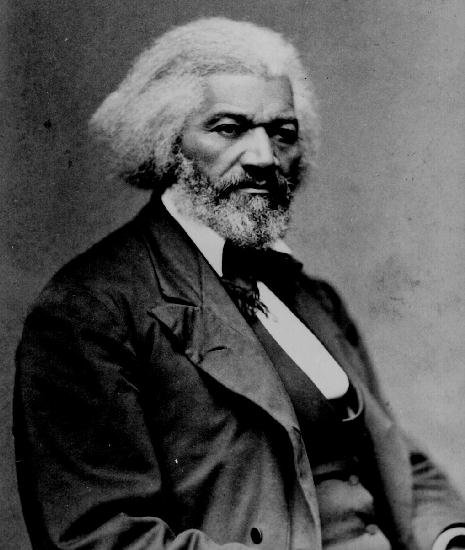Tides of the Past, Part 2: Connecting to the Suffrage Movement and Women’s History in Ohio
By Sherri Goudy
FREDERICK DOUGLAS
Imagine it. It’s 1848, and just eight years after women attempted to participate in the World Antislavery Convention in London. The American Women Delegates from Philadelphia, led by Lucretia Mott, were denied from contributing. Some men protested this, including the keynote speaker at the convention William Lloyd Garrison. When the women were told they could sit only in the no speaking section, Garrison joined them, refused to give his speech, and his silence became his protest.
What would the mood of the country have been like in the late 1840s? There was already a great divide because of the issue of slavery. This was, after all, more than a decade before the Civil War. And now women were demanding equality and a political voice. The opposition to the status quo must have caused immense tensions; neighbors, friends, and families at odds with their views. People must have been disillusioned with the state of their country and wondering if it could even survive.
Despite all of this, most women were actively seeking equal treatment and rights. The first Women’s Rights Convention, also referred to as the Seneca Falls Convention, lasted 2 days, from July 19-20, 1848. Men and women both attended the second day of the convention. The event was organized by Lucretia Mott and Elizabeth Cady Stanton as well as 3 others, Mary M’Clintock, Martha Coffin Wright, and Jane Hunt. These women were highly active with abolitionist activism as well as that for women’s rights. The convention served as a forum for discussions about suffrage as well as other women’s right such as property ownership by married women and women’s right to speak out on moral and political issues.
BETSY MIX COWLES
At the convention, a Declaration of Sentiments was signed by 100 of the 300 participants. It was written by Elizabeth Cady Stanton and outlined the rights American women should be entitled to as citizens. After the reading of this declaration, 11 resolutions related to women’s rights issues were discussed and voted on. All passed unanimously except one—the right to vote for women. However, one of the speakers at this historic first event was abolitionist Frederick Douglass, who gave an impassioned speech in which he stated, “We hold woman to be justly entitled to all we claim for man. We go farther and express our conviction that all political rights which it is expedient for man to exercise, it is equally so for women.” After his speech, the resolution passed, though barely.
After this first Women’s Rights Convention, many women in Ohio were inspired and motivated by the signing of the Declaration of Sentiments. Some, such as Elizabeth Bisbee in Columbus, started local newspapers to fight for equal rights for women.
FRANCES DANA GAGE
Ohio was the first to organize a convention for a statewide audience. The first of these, the Ohio Woman’s Convention, took place on April 19-20, 1850, in Salem, Ohio, presided by Betsy Mix Cowles. It was an impressive gathering, with about 500 attendees. Throughout 1850, several other conventions were organized as well. It was during these conventions that petitions were collected asking that women’s suffrage to be added to the state constitution and that the word “male” be deleted from Ohio’s constitution. Neither of these resolutions passed.
In 1851, Frances Dana Gage organized The Women’s Rights Convention in Akron, Ohio. It was here that she and other participants were aware more than ever of the push back from the community regarding women’s rights to equality. Many ministers and local men showed up at the convention and spoke out stating women were not equal to men. It was then that Sojourner Truth rose and gave her famous “Ain’t I A Woman” speech, pointing to her muscular arms, referring to the hard work she had done as a slave and declaring she could do any work a man could do, “and ain’t I a woman?” By all accounts, as she spoke, the crowd was moved to rise and applaud.
SOJOURNER TRUTH
In 1852, the Women’s Rights Convention was held in Massillon, Ohio. At this event, the Ohio Women’s Rights Association was established. This organization attempted to achieve “equal rights for all human beings” and mirrored what women across the country were doing. However, with the Civil War looming ever closer, and abolitionism and the rights of black men to vote became the focus, these first sparks in the women’s rights movements fizzled for a bit.
Today, we know that the United States did survive this tumultuous time, though not without major conflicts. What’s more, we also know that suffrage passed, and we are nearing the centennial anniversary of this amendment. Have we learned anything in that time? Do we understand fully the sacrifices and struggles endured to give women the right to vote?
Though we haven’t been focusing solely on Dayton or even Ohio, these first few posts have been written in an attempt to set the stage for the Suffrage Movement in Dayton, Ohio. At Children’s Historical Publishing, we want to share these amazing stories with you as we prepare our new book on women’s empowerment and celebrate the great women of Dayton who accomplished so much.
Our community is so important to us, and we hope to give our books to children throughout the community with your help. Since 2002, we have put over 560,000 books into the hands of children, and we couldn’t do it without your support. Please follow us on Facebook and check out our website!





